201871010104-陈园园《面向对象程序设计(java)》第十六周学习总结
| 项目 | 内容 |
| 这个作业属于哪个课程 | https://www.cnblogs.com/nwnu-daizh/ |
| 这个作业要求在哪里 | https://www.cnblogs.com/lily-2018/p/11441372.html |
| 作业学习目标 |
(1) 掌握Java应用程序的打包操作; (2) 掌握线程概念; (3) 掌握线程创建的两种技术。 |
第一部分:总结理论知识
线程的组成
线程ID:线程标识符。
-
当前指令指针(PC):指向要执行的指令。
寄存器集合:存储单元寄存器的集合。
堆栈:暂时存放数据和地址,一般用来保护断点和现场。
线程与进程区别
线程和进程之间的区别,我觉得可以用这个例子来看出两者的不同,进程就是一栋房子,房子住着 3 个人,线程就是住在房子里的人。进程是一个独立的个体,有自己的资源,线程是在进程里的,多个线程共享着进程的资源。
线程状态
我们看到 Java 源代码里面,线程状态的枚举有如下 6 个。
public enum State { //新建状态 NEW, //运行状态 RUNNABLE, //阻塞状态 BLOCKED, //等待状态 WAITING, //等待状态(区别在于这个有等待的时间) TIMED_WAITING, //终止状态 TERMINATED; }下面给这 6 个状态一一做下解释。
NEW:新建状态。在创建完 Thread ,还没执行 start() 之前,线程的状态一直是 NEW。可以说这个时候还没有真正的一个线程映射着,只是一个对象。
RUNNABLE:运行状态。线程对象调用 start() 之后,就进入 RUNNABLE 状态,该状态说明在 JVM 中有一个真实的线程存在。
BLOCKED:阻塞状态。线程在等待锁的释放,也就是等待获取 monitor 锁。
WAITING:等待状态。线程在这个状态的时候,不会被分配 CPU,而且需要被显示地唤醒,否则会一直等待下去。
TIMED_WAITING:超时等待状态。这个状态的线程也一样不会被分配 CPU,但是它不会无限等待下去,有时间限制,时间一到就停止等待。
TERMINATED:终止状态。线程执行完成结束,但不代表这个对象已经没有了,对象可能还是存在的,只是线程不存在了。
线程既然有这么多个状态,那肯定就有状态机,也就是在什么情况下 A 状态会变成 B 状态。下面就来简单描述一下。
结合下图,我们 new 出线程类的时候,就是 NEW 状态,调用 start() 方法,就进入了 RUNNABLE 状态,这时如果触发等待,则进入了 WAITING 状态,如果触发超时等待,则进入 TIMED_WAITING 状态,当访问需要同步的资源时,则只有一个线程能访问,其他线程就进入 BLOCKED 状态,当线程执行完后,进入 TERMINATED 状态。
线程的组成
线程ID:线程标识符。
当前指令指针(PC):指向要执行的指令。
寄存器集合:存储单元寄存器的集合。
堆栈:暂时存放数据和地址,一般用来保护断点和现场。
线程与进程区别
线程和进程之间的区别,我觉得可以用这个例子来看出两者的不同,进程就是一栋房子,房子住着 3 个人,线程就是住在房子里的人。进程是一个独立的个体,有自己的资源,线程是在进程里的,多个线程共享着进程的资源。
线程状态
我们看到 Java 源代码里面,线程状态的枚举有如下 6 个。
public enum State { //新建状态 NEW, //运行状态 RUNNABLE, //阻塞状态 BLOCKED, //等待状态 WAITING, //等待状态(区别在于这个有等待的时间) TIMED_WAITING, //终止状态 TERMINATED; }下面给这 6 个状态一一做下解释。
NEW:新建状态。在创建完 Thread ,还没执行 start() 之前,线程的状态一直是 NEW。可以说这个时候还没有真正的一个线程映射着,只是一个对象。
RUNNABLE:运行状态。线程对象调用 start() 之后,就进入 RUNNABLE 状态,该状态说明在 JVM 中有一个真实的线程存在。
BLOCKED:阻塞状态。线程在等待锁的释放,也就是等待获取 monitor 锁。
WAITING:等待状态。线程在这个状态的时候,不会被分配 CPU,而且需要被显示地唤醒,否则会一直等待下去。
TIMED_WAITING:超时等待状态。这个状态的线程也一样不会被分配 CPU,但是它不会无限等待下去,有时间限制,时间一到就停止等待。
TERMINATED:终止状态。线程执行完成结束,但不代表这个对象已经没有了,对象可能还是存在的,只是线程不存在了。
线程既然有这么多个状态,那肯定就有状态机,也就是在什么情况下 A 状态会变成 B 状态。下面就来简单描述一下。
结合下图,我们 new 出线程类的时候,就是 NEW 状态,调用 start() 方法,就进入了 RUNNABLE 状态,这时如果触发等待,则进入了 WAITING 状态,如果触发超时等待,则进入 TIMED_WAITING 状态,当访问需要同步的资源时,则只有一个线程能访问,其他线程就进入 BLOCKED 状态,当线程执行完后,进入 TERMINATED 状态。
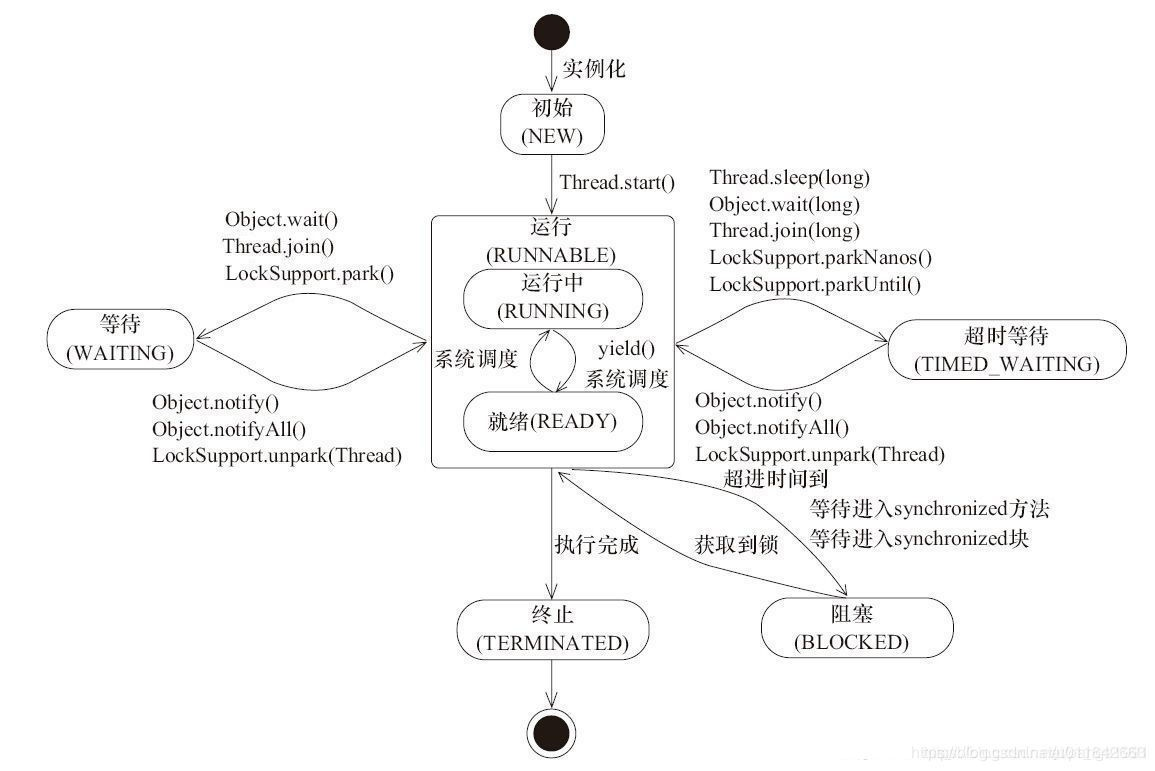
Java 中如何创建一个线程
继承 Thread 类,重写 run() 方法。
class MyThread extends Thread {
@Override
public void run() {
System.out.println("MyThread");
}
}
实现 Runnable 接口,实现 run() 方法。
class MyRunnable implements Runnable {
public void run() {
System.out.println("MyRunnable");
}
}
这 2 种线程的启动方式也不一样。MyThread 是一个线程类,所以可以直接 new 出一个对象出来,接着调用 start() 方法来启动线程;而 MyRunnable 只是一个普通的类,需要 new 出线程基类 Thread 对象,将 MyRunnable 对象传进去。
线程在Running的过程中可能会遇到阻塞(Blocked)情况:
- 调用
join()和sleep()方法,sleep()时间结束或被打断,join()中断,IO完成都会回到Runnable状态,等待JVM的调度。 - 调用
wait(),使该线程处于等待池(wait blocked pool),直到notify()/notifyAll(),线程被唤醒被放到锁定池(lock blocked pool ),释放同步锁使线程回到可运行状态(Runnable) - 对Running状态的线程加同步锁(Synchronized)使其进入(lock blocked pool ),同步锁被释放进入可运行状态(Runnable)。
1.实现Runnable接口,重载run(),无返回值,Runnable接口的存在主要是为了解决Java中不允许多继承的问题。
2.继承Thread类,重写run(),通过调用Thread的start()会调用创建线程的run(),不同线程的run方法里面的代码交替执行。但由于Java不支持多继承.因此继承Thread类就代表这个子类不能继承其他类.
- 同步:synchronized,同步的概念就是共享,只需要针对共享的资源,才需要考虑同步。
线程同步,是指线程之间所具有的一种制约关系,一个线程的执行依赖另一个线程的消息,当它没有得到另一个线程的消息时应等待,直到消息到达时才被唤醒。
线程中断机制是一种协作机制,也就是说通过中断并不能直接终止另一个线程,而需要被中断的线程自己处理。
三个中断方法:
1、interrupt()
2、isInterrupted():方法唯一的作用只是测试线程是否已经中断。
3、interrupted():方法的作用是测试当前线程是否已经中断,线程的中断标识位由该方法清除。
线程终止:
1、使用 volatile 关键字修饰 变量的方式终止
2、使用 interrupt() 方式终止
3、Stop 方法终止
可以直接使用thread.stop()来强行终止线程,但是stop方法是很危险的,就象突然关闭计算机电源,而不是按正常程序关机一样,可能会产生不可预料的结果。
线程处于阻塞状态
线程处于阻塞状态,如使用了sleep,同步锁的wait,socket中的receiver,accept等方法时,会使线程处于阻塞状态。当调用线程的interrupt()方法时,会抛出InterruptException异常。阻塞中的那个方法抛出这个异常,通过代码捕获该异常,然后break跳出循环状态,从而让我们有机会结束这个线程的执行。
第二部分:实验测试
实验1: 导入第13章示例程序,测试程序并进行代码注释。
测试程序1
1) 在elipse IDE中调试运行教材585页程序13-1,结合程序运行结果理解程序;
2)将所生成的JAR文件移到另外一个不同的目录中,再运行该归档文件,以便确认程序是从JAR文件中,而不是从当前目录中读取的资源。
掌握创建JAR文件的方法;
import java.awt.*;
import java.io.*;
import java.net.*;
import java.util.*;
import javax.swing.*;
/**
* @version 1.41 2015-06-12
* @author Cay Horstmann
*/
public class ResourceTest
{
public static void main(String[] args)
{
EventQueue.invokeLater(() -> {
JFrame frame = new ResourceTestFrame();
frame.setTitle("ResourceTest");
frame.setDefaultCloseOperation(JFrame.EXIT_ON_CLOSE);
frame.setVisible(true);
});
}
}
/**
* A frame that loads image and text resources.
*/
class ResourceTestFrame extends JFrame
{
private static final int DEFAULT_WIDTH = 300;
private static final int DEFAULT_HEIGHT = 300;//定义窗口宽和高
public ResourceTestFrame()//构造器
{
setSize(DEFAULT_WIDTH, DEFAULT_HEIGHT);
URL aboutURL = getClass().getResource("about.gif");//URL来指向about.gif资源地址
Image img = new ImageIcon(aboutURL).getImage();//利用about.gif图像文件制作图标,在找到ResourceTest类的地方查找about.gif文件
setIconImage(img);
JTextArea textArea = new JTextArea();//创建文本区
InputStream stream = getClass().getResourceAsStream("about.txt");//读取about.txt文件
try (Scanner in = new Scanner(stream, "UTF-8"))
{
while (in.hasNext())
textArea.append(in.nextLine() + "
");
}
add(textArea);
}
}
运行结果:

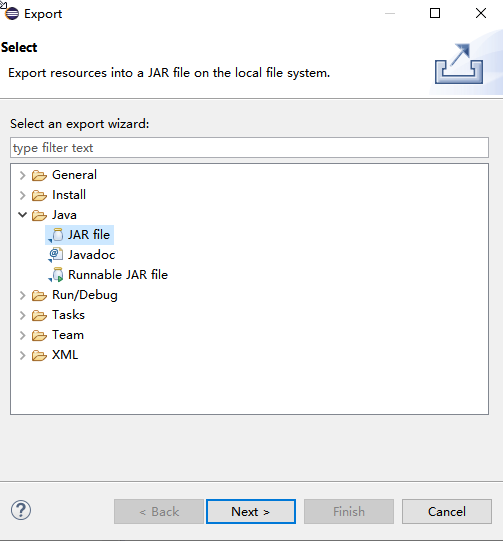
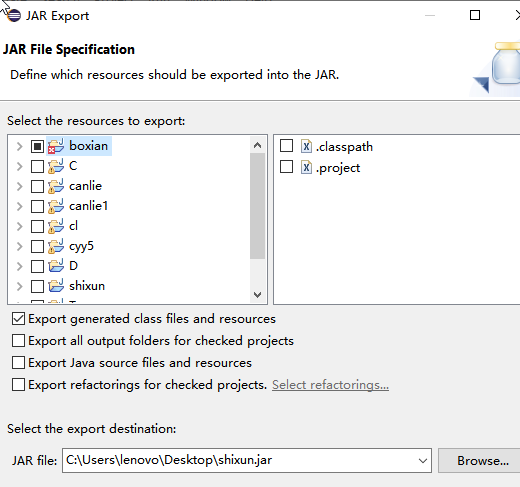


测试程序2:
1)在elipse IDE中调试运行ThreadTest,结合程序运行结果理解程序;
2) 掌握线程概念;
3) 掌握用Thread的扩展类实现线程的方法;
4)利用Runnable接口改造程序,掌握用Runnable接口创建线程的方法。
class Lefthand extends Thread {
public void run()
{
for(int i=0;i<=5;i++)
{ System.out.println("You are Students!");
try{ sleep(500); }
catch(InterruptedException e)
{ System.out.println("Lefthand error.");}
}
}
}
class Righthand extends Thread {
public void run()
{
for(int i=0;i<=5;i++)
{ System.out.println("I am a Teacher!");
try{ sleep(300); }
catch(InterruptedException e)
{ System.out.println("Righthand error.");}
}
}
}
public class ThreadTest
{
static Lefthand left;
static Righthand right;
public static void main(String[] args)
{ left=new Lefthand();
right=new Righthand();
left.start();
right.start();
}
}
运行结果:

测试程序3:
1)在Elipse环境下调试教材625页程序14-1、14-2 、14-3,结合程序运行结果理解程序;
2) 在Elipse环境下调试教材631页程序14-4,结合程序运行结果理解程序;
3)对比两个程序,理解线程的概念和用途;
4)掌握线程创建的两种技术。
import java.awt.*; import java.util.*; import javax.swing.*; /** * The component that draws the balls. * @version 1.34 2012-01-26 * @author Cay Horstmann */ public class BallComponent extends JPanel { private static final int DEFAULT_WIDTH = 450; private static final int DEFAULT_HEIGHT = 350; private java.util.List<Ball> balls = new ArrayList<>(); /** * Add a ball to the component. * @param b the ball to add */ public void add(Ball b) { balls.add(b); } public void paintComponent(Graphics g) { super.paintComponent(g); // 擦除背景 Graphics2D g2 = (Graphics2D) g; for (Ball b : balls) { g2.fill(b.getShape()); } } public Dimension getPreferredSize() { return new Dimension(DEFAULT_WIDTH, DEFAULT_HEIGHT); } }
import java.awt.*; import java.awt.event.*; import javax.swing.*; /** * Shows an animated bouncing ball. * @version 1.34 2015-06-21 * @author Cay Horstmann */ public class Bounce { public static void main(String[] args) { EventQueue.invokeLater(() -> { JFrame frame = new BounceFrame(); frame.setDefaultCloseOperation(JFrame.EXIT_ON_CLOSE); frame.setVisible(true); }); } } /** * The frame with ball component and buttons. */ class BounceFrame extends JFrame { private BallComponent comp; public static final int STEPS = 1000; public static final int DELAY = 3; /** * Constructs the frame with the component for showing the bouncing ball and * Start and Close buttons */ public BounceFrame() { setTitle("Bounce"); comp = new BallComponent(); add(comp, BorderLayout.CENTER);//使用边框布局管理器使其显示在窗口中心位置 JPanel buttonPanel = new JPanel(); addButton(buttonPanel, "Start", event -> addBall());//在窗口添加两个按钮 addButton(buttonPanel, "Close", event -> System.exit(0)); add(buttonPanel, BorderLayout.SOUTH);//使用边框布局管理器使其显示在窗口下方位置 pack(); } /** * Adds a button to a container. * @param c the container * @param title the button title * @param listener the action listener for the button */ public void addButton(Container c, String title, ActionListener listener) { JButton button = new JButton(title); c.add(button); button.addActionListener(listener); } /** * Adds a bouncing ball to the panel and makes it bounce 1,000 times. */ public void addBall() { try { Ball ball = new Ball(); comp.add(ball); for (int i = 1; i <= STEPS; i++) { ball.move(comp.getBounds()); comp.paint(comp.getGraphics()); Thread.sleep(DELAY); } } catch (InterruptedException e) { } } }
import java.awt.geom.*;
/**
* A ball that moves and bounces off the edges of a rectangle
* @version 1.33 2007-05-17
* @author Cay Horstmann
*/
public class Ball
{
private static final int XSIZE = 15;
private static final int YSIZE = 15;
private double x = 0;
private double y = 0;
private double dx = 1;
private double dy = 1;
/**
* 将球移动到下一个位置,如果球碰到其中一条边,则反向移动
*/
public void move(Rectangle2D bounds)
{
x += dx;
y += dy;
if (x < bounds.getMinX())
{
x = bounds.getMinX();
dx = -dx;
}
if (x + XSIZE >= bounds.getMaxX())
{
x = bounds.getMaxX() - XSIZE;
dx = -dx;
}
if (y < bounds.getMinY())
{
y = bounds.getMinY();
dy = -dy;
}
if (y + YSIZE >= bounds.getMaxY())
{
y = bounds.getMaxY() - YSIZE;
dy = -dy;
}
}
/**
*获取球在当前位置的形状。
*/
public Ellipse2D getShape()
{
return new Ellipse2D.Double(x, y, XSIZE, YSIZE);
}
}
运行结果:
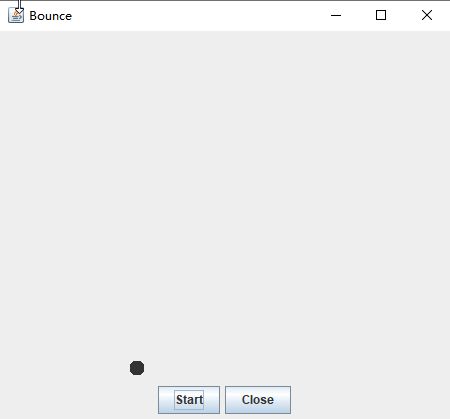
package bounceThread;
import java.awt.*;
import java.awt.event.*;
import javax.swing.*;
/**
* Shows animated bouncing balls.
* @version 1.34 2015-06-21
* @author Cay Horstmann
*/
public class BounceThread
{
public static void main(String[] args)
{
EventQueue.invokeLater(() -> {
JFrame frame = new BounceFrame();
frame.setTitle("BounceThread");
frame.setDefaultCloseOperation(JFrame.EXIT_ON_CLOSE);
frame.setVisible(true);
});
}
}
/**
* The frame with panel and buttons.
*/
class BounceFrame extends JFrame
{
private BallComponent comp;
public static final int STEPS = 1000;
public static final int DELAY = 5;
/**
* Constructs the frame with the component for showing the bouncing ball and
* Start and Close buttons
*/
public BounceFrame()
{
comp = new BallComponent();
add(comp, BorderLayout.CENTER);//使用边框布局管理器将它放在窗口的中心位置
JPanel buttonPanel = new JPanel();
addButton(buttonPanel, "Start", event -> addBall());
addButton(buttonPanel, "Close", event -> System.exit(0));
add(buttonPanel, BorderLayout.SOUTH);//使用边框布局管理器将它放在窗口的中心位置
pack();
}
/**
* Adds a button to a container.
* @param c the container
* @param title the button title
* @param listener the action listener for the button
*/
public void addButton(Container c, String title, ActionListener listener)
{
JButton button = new JButton(title);
c.add(button);
button.addActionListener(listener);
}
/**
* Adds a bouncing ball to the canvas and starts a thread to make it bounce
*/
public void addBall()
{
Ball ball = new Ball();
comp.add(ball);
Runnable r = () -> {
try
{
for (int i = 1; i <= STEPS; i++)
{
ball.move(comp.getBounds());
comp.repaint();
Thread.sleep(DELAY);
}
}
catch (InterruptedException e)
{
}
};
Thread t = new Thread(r);
t.start();//调用Thread类中的start方法
}
}
运行结果:
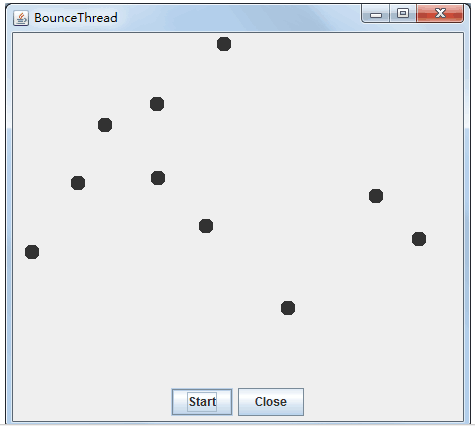
实验总结:
在上节课的基础之上,又了解了一些新的知识,学习了并发,线程的创建,中断线程,线程与进程的区别,以及多线程问题等。除了之前了解的一些基础代码之外,又学会了很多其他新的代码知识以及所表示的不同含义与用法。后一节课在老师的讲解下学习了同步。java就这样学完了,以后慢慢回顾反思。